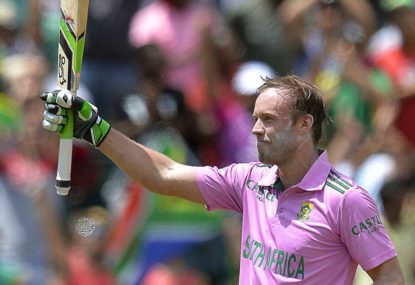The cricketing world was recently shocked by the sudden retirement of AB de Villiers, at what seemed to be the peak of his career. His explanation was simple – he is tired.
Why a premier player burned out at a relatively young age playing what is not exactly an endurance sport is worth considering.
De Villiers is not alone in this either. Virat Kohli said in an interview in March this year that non-stop cricket is beginning to take a toll on his body. Steve Smith said after the Ashes and England ODI series that he was so tired that he did not want to lift a bat.
And these are batsmen, on whom the game extracts a lesser toll than fast bowlers.
The fact is that with three formats, numerous bilateral series, World Cups in different formats and global T20 leagues, cricket has become one of the most chaotic sports from a scheduling perspective.
Financial considerations for individual boards and the ICC seem to have overridden good sense – how else to explain two T20 World Cups that will be held in 2020 and 2021 – the space of a year? One year after the ODI World Cup in 2019 – it almost seems as if the ICC wants to schedule a global tournament every year.
The mushrooming of several T20 leagues around the world has added to the woes. Apart from the big ones – the IPL and the BBL – there are leagues in Pakistan, Bangladesh, Sri Lanka, Afghanistan, UAE (apparently several) and now even Canada!
As if it were not chaotic enough, the ECB is now planning to introduce a fourth format for cricket – the Hundred!
[latest_videos_strip category=”cricket” name=”Cricket”]
While the leagues are money spinners for their respective boards, they have added an increased workload on players. For many, playing in the leagues is more lucrative than national contracts. This has led to an ‘each player for himself’ regime – where individual players pick and choose how many and which leagues they will play for, and how they will accommodate them with their national commitments.
While some players choose smartly and accommodate rest periods, many sign up for all tournaments they can – this is understandable, since the career span of a professional sportsperson is relatively short and they want to earn as much as they can while they can.
However, by over-working their bodies, they are shortening their playing years and having a detrimental effect on their earning potential.
Interspersed with all the leagues is a plethora of bilateral series, several of which are meaningless except for the purpose of earning revenue for the respective boards.
While some of these bilateral series include Test matches, many of them are ODIs and T20s – highly forgettable in the surfeit of cricket that is already being served up.
Adding to the jumble is the fact that, because the individual boards schedule the bilateral series purely for financial reasons, some teams are in high demand and their players are overworked while nobody wants to play the others. The individual boards are being short-sighted in not recognising that an overdose of cricket among the same four or five teams will bore and eventually turn off their viewers.
Into this pre-existing mess, the ICC now wants to add a World Test Championship, in which all teams will have to play two Test series (one home and one away) against six other ICC members that have Test status, within a span of two years.
That’s 27 Test series that need to be scheduled within two years. How exactly will this be achieved?
Few other sports have so many formats and so many tournaments – football has several leagues, but the international games are limited to big events such as the World Cup, the Euro Cup or the Olympics. Baseball in the USA is highly organised and so is basketball.
In order to organise the various events in a smooth manner and to provide the players with clarity, the ICC and individual boards need to work out a definitive schedule which all member countries abide by. Some suggestions are below:
1. The T20 leagues must be graded into A-League and B-leagues. Two months in the summer and two months in the winter are blocked out for T20 league games and all the A-Leagues have to be scheduled during this time. This will make the players choose which leagues they wish to play for and ensure that manage their workload sensibly. No international tournaments will be scheduled during these months.
2. B-league matches can be scheduled at any time but players on national contracts for international matches cannot feature.
3. One or two months of the year are blocked for the annual World Cup (ODI/T20).
4. Two Test series per month need to be scheduled in the remaining months in order to meet the target of the World Test Championship. Most likely every team will have to play a series once every two months – a reasonable time frame considering that some series, like the Ashes and the India-Australia series, involve five matches.
5. Every team must play at least one Test match with and hosted by an Associate nation every year.
6. All players must have mandatory one-month rest during the year.
Unless the ICC gets its act together in working out a reasonable schedule, accommodating all three formats, players will be forced to choose which formats they want to play and whether they even want to play in their national side.
Considering the significant financial incentive offered by T20, it might become an obvious choice, to the detriment of Test and international cricket.






























































































